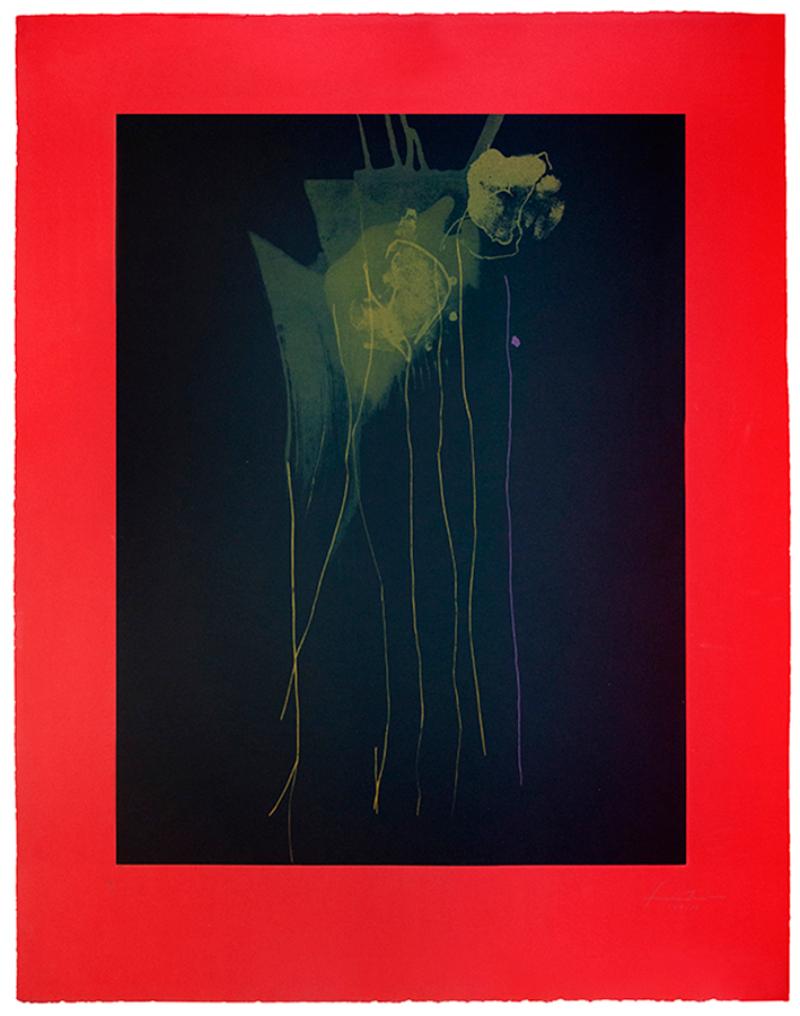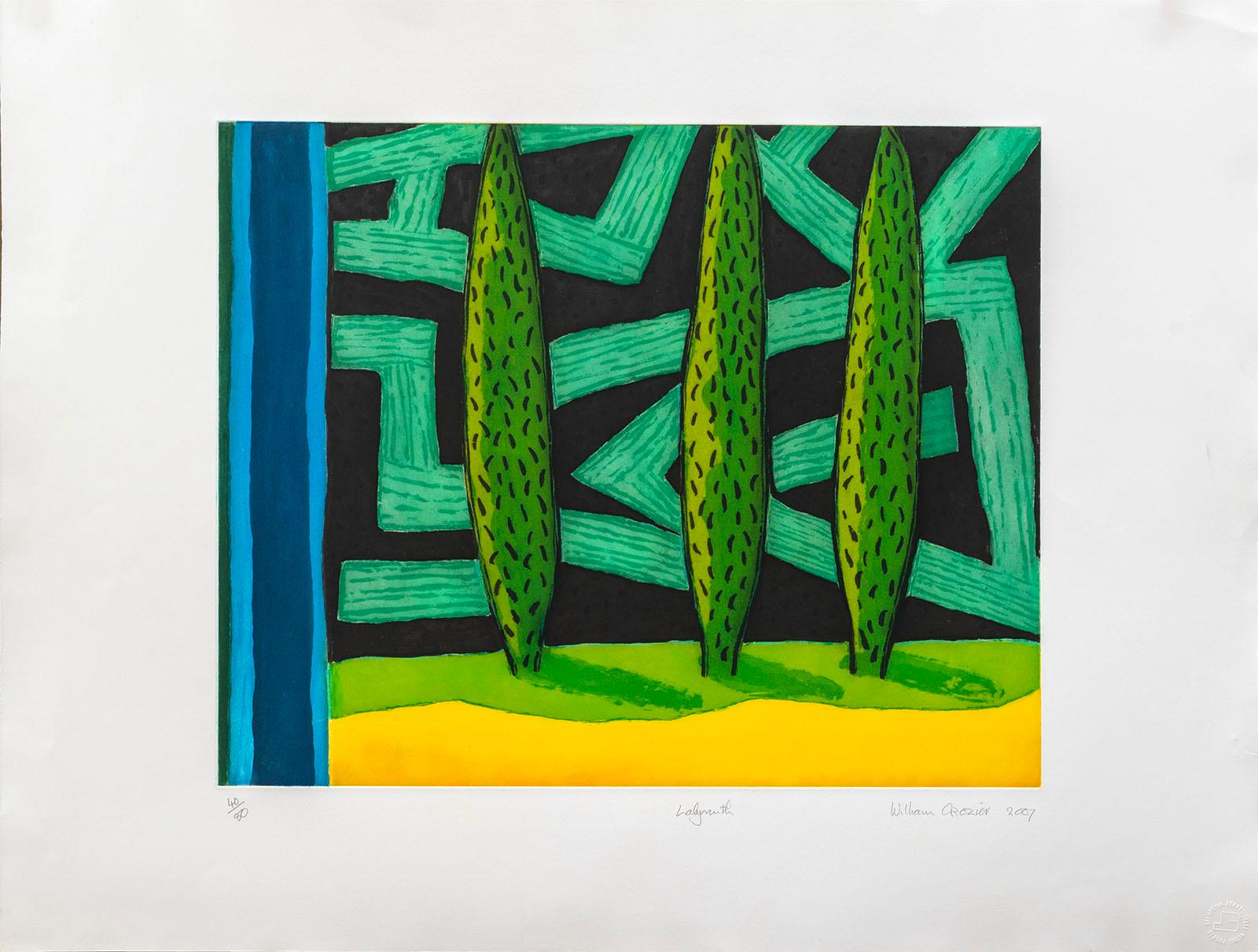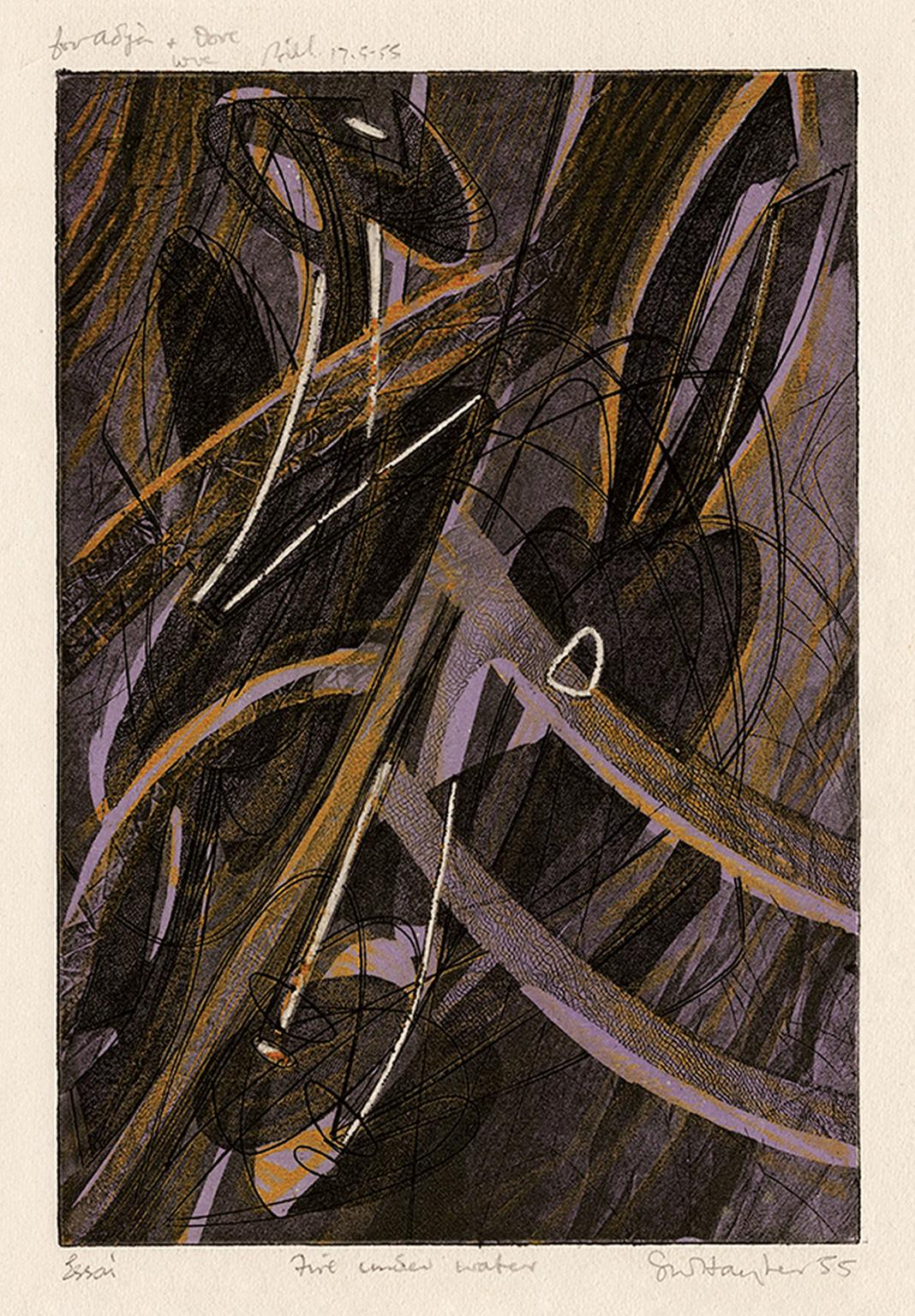Items Similar to Abstract Expressionist Engraving on Handmade Paper, 'Profile and Letters'.
Want more images or videos?
Request additional images or videos from the seller
1 of 13
James CoignardAbstract Expressionist Engraving on Handmade Paper, 'Profile and Letters'.
About the Item
Late 20th century carborundum engraving on handmade paper by French artist, James Coignard.
In the late 1960s, Coignard exploited in particular the artistic medium of etching in carborundum (first created by Henri Goetz) . It was his tireless experimentation in the search for a new artistic medium that led him to the further development of etching on carborundum, a very time-consuming process.
At the start of his career, Coignard became part of the 'realists' of the École de Paris .
Although he was always searching for a way out of the modern art genre, his work always had a modern art vibe. Marcelin Pleynet , in 'James Coignard and the memory of signs', writes: “the work of James Coignard presents all the characteristics of a work belonging to the space of modern art […] the work of James Coignard seems curiously silent as soon as we try to compare it, to think about it, to understand it according to such or such conventional data." That is its essence.
In 1948 , James Coignard discovered the Côte d'Azur and decided to take courses at the School of Decorative Arts in Nice. He then also received advice from Louis Marchand des Raux, to whom he was close. In his early days, he was a ceramicist . His meeting with Paul Hervieu, gallery owner in Nice in 1950 , was decisive for his career. Coignard exhibited for the first time in Beaulieu-sur-Mer and it was through Paul Hervieu that he met Braque, Matisse and Chagall .
In 1952, he moved to Paris and set up his ceramic workshop. He began to exhibit in Scandinavian countries. He married Mireille Poupart and eventually returned to Beaulieu-sur-mer in 1956 , where he set up his workshop. At that time other influencial artists in the region were Atlan, Christine Boumeester, Henri Goetz and Max Papart.
In 1958, Coignard stopped practicing ceramics to devote himself to painting. In the 1960s ,his career took on an international dimension, particularly in the United States and Sweden . He then travelled around the world and tried out new techniques such as tapestry and glass sculpture.
In 1968, with Henri Goetz, Coignard made his first carborundum engravings; a process, the multiple possibilities and facets of which he explored until the end of his life. From 1969 , he became interested in publishing issues and worked on his first artists' books .
In the 2000s, he strengthened his collaboration with the GKM Siwert Bergström gallery in Malmö , Sweden, with which he continued to collaborate in developing his engraved work.
- Creator:James Coignard (1925-2008, French)
- Dimensions:Height: 22.45 in (57 cm)Width: 14.97 in (38 cm)
- Medium:
- Movement & Style:
- Period:
- Condition:
- Gallery Location:Cotignac, FR
- Reference Number:
James Coignard
James Coignard, painter, ceramist, sculptor and etcher, was born in Tours in 1925. At the age of 23 and after a brief career in the French administration, he discovers the landscapes of the French Riviera and decides to study at Arts décoratifs in Nice. Four years later, he quits his job at the administration to commit himself entirely to his artistic career. The encounter with Paul Hervieu in 1950 is decisive. His collaboration with gallery Hervieu made him known in artistic circles, nationally and internationally and then particularly in Scandinavia. At the beginning of his career, art critics label James Coignard as a member of Ecole de Paris. Soon, his painting and ceramic distances themselves from those of his colleagues and he goes it alone. At the beginning of the sixties, he starts to work with glass but the technical turning point occurs in 1968 when his friend Henri Goetz discovers a new etching technique, using carborundum. Etching then becomes central in his work. At the same time, his career takes off internationally. He travels a lot, especially to Sweden and USA where he lives during a few years. 1978, James Coignard participates in the creation of the etching studio Pasnic, with which he starts a long collaboration. During the eighties, he shares his time between Paris and the French Riviera and takes an interest in artist’s books and publishing issues. He exhibits now all over the world, and is acknowledged as one of the greatest painter-etchers of his time. Until his decease in 2008, James Coignard was a prolific painter, sculptor and etcher and leaves behind an immense work.
About the Seller
5.0
Platinum Seller
These expertly vetted sellers are 1stDibs' most experienced sellers and are rated highest by our customers.
Established in 2000
1stDibs seller since 2020
172 sales on 1stDibs
Typical response time: 1 hour
- ShippingRetrieving quote...Ships From: Cotignac, France
- Return PolicyA return for this item may be initiated within 3 days of delivery.
More From This SellerView All
- Abstract Expressionist, Art Brut Lithograph, 'A Day Out'.Located in Cotignac, FRAbstract Expressionist lithograph on BFK Rives paper of a late 20th century work by French artist Eliane Larus. A lively and highly colourful lithograph...Category
Late 20th Century Abstract Expressionist Abstract Prints
MaterialsLithograph
- Double Sided Abstract Expressionist Monotypes on Handmade Paper.Located in Cotignac, FRA double sided work of two abstract expressionist monotypes on hand-made paper from an original work by Martin Engelman. The paper has one monotype to each side. See photos. The work...Category
Mid-20th Century Abstract Expressionist Abstract Prints
MaterialsMonotype
- Constructivist Abstract From Album MA 1921By Sándor BortnyikLocated in Cotignac, FRA folio sheet from the Album MA by Sándor Bortnyik. Signed in pencil by the artist bottom right, numbered in pencil bottom left, number 50 from the edition of 140. Presented in plain...Category
Late 20th Century Constructivist Abstract Prints
MaterialsPaper, Lithograph
- "Redoutable" (Formidable) Colourful French Abstract Expressionist Oil on Board.Located in Cotignac, FRLate 20th century abstract Expressionist oil on board by French artist Emmanuelle Bardet. Signed bottom left and dated 1995 and titled "Redoutable" (Formidable) to the reverse. The a...Category
Late 20th Century Abstract Expressionist Abstract Paintings
MaterialsOil, Board
- Collection of Three French Oils on Board. "La Cagole, Redoutable & La Corrida".Located in Cotignac, FRLate 20th century collection of three abstract expressionist oils on board by French artist Emmanuelle Bardet. All signed to the front and each dated 1995 and titled to the reverse. The three paintings are titled; La Cagole...Category
Late 20th Century Abstract Expressionist Abstract Paintings
MaterialsOil, Board
- Colourful Mixed-Media Sculptural 'Montage', Hommage to Gaugin's "Manau Tupapau"By Armand AvrilLocated in Cotignac, FRGaugin inspired 'montage' titled 'Manau Tupapau' (spirit of the dead watching) by French artist, Armand Avril. Signed and dated 2004 to the bottom right and mou...Category
Late 20th Century Abstract Expressionist Mixed Media
MaterialsWood, Acrylic, Cardboard, Oil
You May Also Like
- RamblasBy Helen FrankenthalerLocated in London, GBLithograph, drypoint, etching in colours, 1987/88, on handmade wove paper, signed in pencil, numbered from the edition of 75, printed and published by Polígrafa Obra Gráfica, Barcelo...Category
1980s Abstract Expressionist Abstract Prints
MaterialsDrypoint, Etching, Lithograph
- LabyrinthBy William CrozierLocated in Llanbrynmair, GB’Labyrinth’ By William Crozier Medium - Carborundum printmaking, collagraph process Edition - 47/80 Signed - Yes Size - 509mm x 407mm Date - 2007 Condition - Excellent. 10 out of 10....Category
21st Century and Contemporary Abstract Expressionist Landscape Prints
MaterialsLithograph, Mezzotint
- Large Italian Aquatint Etching Francesco Clemente Neo Expressionist Avant GardeBy Francesco ClementeLocated in Surfside, FLFrancesco Clemente (Italian b. 1952), 'This side up / Telemone #2, 1981 Medium: Intaglio hard ground etching, color aquatint, drypoint, and soft-ground etching with chine collé (ha...Category
1980s Abstract Expressionist Abstract Prints
MaterialsDrypoint, Etching, Aquatint, Intaglio
- UntitledBy Henri GoetzLocated in Fairlawn, OHUntitled Engraving, drypoint & carborundum, c. 1960's Signed and numbered in pencil (see photos) Edition: 25 (9/25) Printed by the artist Condition: Adhesive residue on the verso to...Category
1960s Abstract Expressionist Abstract Prints
MaterialsEngraving
- Crowd of Shadows, Abstract Mezzotint by Kyu-Baik HwangBy K.B. (Kyu-Baik ) HwangLocated in Long Island City, NYArtist: K.B. (Kyu-Baik) Hwang, Korean (1932 - ) Title: Crowd of Shadows Year: circa 1970 Medium: Mezzotint, signed and numbered in marker Edition: 50 Size: 30 x 22 in. (76.2 x 5...Category
1970s Abstract Expressionist Abstract Prints
MaterialsMezzotint
- 'Feu sous L'eau' (Fire Under Water) —Mid-century Modernism, Atelier 17By Stanley William HayterLocated in Myrtle Beach, SCStanley William Hayter, 'Feu sous L'eau (Fire Under Water)', color engraving, soft-ground etching and scorper with yellow silkscreen, 1955, edition 50 plus 10 artist proofs, Black & Moorhead 221. Signed, titled 'Fire Under Water', dated and annotated 'Essai' in pencil. Dedicated in the artist’s hand 'for Adja & Dove WH Bill 17–5–55' in the top margin. A superb, richly inked impression with fresh colors, on heavy, cream wove paper; wide margins (2 1/2 to 3 7/8 inches), in excellent condition. One of 10 artist’s proofs. Image size 10 3/16 x 7 inches; sheet size 18 1/8 x 12 1/4 inches. Matted to museum standards, unframed. ABOUT THIS WORK In 1950 Hayter returned to Paris and reopened Atelier 17. Works such as 'Fire Under Water' reveal newfound influences, such as that of the Ardèche area of southern France, where he acquired a house in 1951 and frequently visited. Hayter took great interest in the flowing Escoutay River, an experience that parallels the artist and co-director of Atelier 17 Krishna Reddy’s interest in depicting water. While some forms in this print evoke the natural world, the palette of contrasting tones of purple, yellow, black, and white reflects Hayter’s belief in using color intuitively to express emotions and evoke feelings. The sharp white relief lines from the paper and the textural effects realized through soft-ground etching operate in tandem with the sweeping curves and bold colors to give the composition a sense of vitality and dynamism. —edited from the Metropolitan Museum of Art Published by 'La Jeune Gravure Contemporaine', Paris. Impressions of this work are in the following collections: British Museum, Metropolitan Museum of Art, National Gallery of Art. ABOUT THE ARTIST Stanley William Hayter (1901-1988) was a British painter and printmaker associated in the 1930s with Surrealism and from 1940 onward with Abstract Expressionism. Regarded as one of the most significant printmakers of the 20th century, Hayter founded the legendary Atelier 17 studio in Paris, now known as Atelier Contrepoint. Among the artists he is credited with influencing are Pablo Picasso, Alberto Giacometti, Joan Miró, Alexander Calder, and Marc Chagall. The hallmark of the workshop was its egalitarian structure, breaking sharply with the traditional French engraving studios by insisting on a cooperative approach to labor and technical discoveries. In 1929 Hayter was introduced to Surrealism by Yves Tanguy and André Masson, who, with other Surrealists, worked with Hayter at Atelier 17. The often violent imagery of Hayter’s Surrealist period was stimulated in part by his passionate response to the Spanish Civil War and the rise of Fascism. He organized portfolios of graphic works to raise funds for the Spanish cause, including Solidarité (Paris, 1938), a portfolio of seven prints, one of them by Picasso. Hayter frequently exhibited with the Surrealists during the 1930s but left the movement when Paul Eluard was expelled. Eluard’s poem Facile Proie (1939) was written in response to a set of Hayter’s engravings. Other writers with whom Hayter collaborated included Samuel Beckett and Georges Hugnet. Hayter joined the exile of the Parisian avant-garde in 1939, moving with his second wife, the American sculptor Helen Phillips...Category
1950s Abstract Expressionist Abstract Prints
MaterialsEngraving, Etching
Recently Viewed
View AllMore Ways To Browse
Henri Matisse Etching
Matisse Signed Etching
1960s French Tapestry
Matisse Nice
Chagall Workshop
Modern Abstract Scandinavian Paintings
Chagall Nice
Henri Matisse Nice
Chagall Ceramic
Papart Max
James Coignard Etching
Max Papart Carborundum
Louis Coignard
1969 Original Lithograph By Joan Miro
Calder Composition
Calder Kinetic Sculpture
Circus 1940
Crown Point Press





